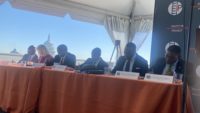Technology, Economic Development Are Key For Transportation Funding And Support, Say Officials
Transportation officials are calling for greater unity among modes and emphasis on infrastructure as an economic development tool in order to increase public support for funding.
"Transportation is increasingly about place-making," said U.S. Dept. of Transportation Secretary Anthony Foxx, addressing members of the Women's Transportation Seminar in Washington, D.C., during a day-long symposium on Sept. 17. He added, "We have to husband our resources to be as efficient as we can."
For example, he noted that ramping up use of construction methods such as warm-mix asphalt could save $3.5 billion by 2020 and that ushering in NextGen air-traffic-control technology would reduce flight delays by 41% and save seven million gallons of fuel a year.
Throughout the day, panelists discussed how technology and innovative financing are influencing transportation projects. In Washington, D.C., Amtrak and a private developer bought air rights above Union Station. The team plans to build a three-level concourse along with related area improvements. "We are aiming to have the best transit-oriented development in the country," said Beverley Swaim-Staley, Union Station Redevelopment Corp. president and CEO.
Elsewhere, a proposed 22-mile alignment in Atlanta to redevelop industrial land is fueled by a special tax allocation district in which future property tax monies will repay bonds, noted Sarah Kline, research director for Transportation for America, an advocacy coalition. She noted that a Washington, D.C., metro station that opened in 2004 was funded up front by property owners who knew the station would increase their property values.
The impending arrival of driverless vehicles will be a huge game-changer, possibly reducing the figure of more than 32,000 annual highway fatalities, said Gregory Winfree, acting administrator of research and innovative technology for U.S. DOT. He noted the potential to combine driverless-vehicle communications with bridge monitoring sensors and toll transponders.
Driverless vehicles will be part of integrated corridor management, added Patrick McGowan, president of North America transportation for Schneider Electric. For example, if an accident backs up traffic in a tunnel, the surrounding traffic signals could be altered, additional transit vehicles provided and toll prices changed—all within minutes, he said. "It's about smart cities, and transportation plays a key role. We have to share data among all modes," he said.


